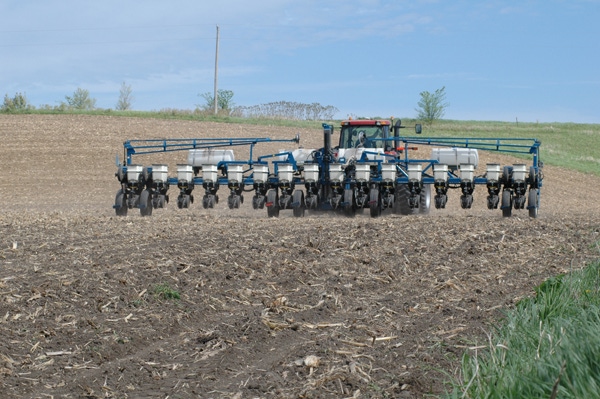June 3, 2011

It's inevitable when cornand soybeanacreages remain unplanted on June 1 to hear the question, "When is it too late to plant?" Although prevented-planting insurance changes things, there's no "drop-dead" date for planting, says University of Illinois Extension Agronomist Emerson Nafziger.
Instead, he says growers need to consider what yields they can expect as planting stretches into June. Using this information, they can decide at what point yield levels and added costs of planting will make the crop less profitable than collecting insurance.
Based on previous studies, Nafziger says growers can expect that corn has lost about 25% of its maximum yield when planted the first few days of June.
"That number will seem high to some and low to others, based on experience," Nafziger says. "The number really is highly variable; we have had 200-bu. corn planted in early June, and we have had yields near zero. The only factor that's of some use when trying to guess which end of this yield range a field might be on is soil productivity."
Nafziger says planting onto soils with good drainage and high water-holding capacity will likely mean higher yields than planting on droughty or heavy, poorly drained soils that typically are the last to be planted. Still, growing conditions the rest of the season will be by far the largest factor in what yields growers realize from late-planted corn.
Hybrids should probably not be changed to earlier-maturing ones in central and southern Illinois, unless the first-choice hybrid in central Illinois was late – above 114-day relative maturity (RM), he says.
"In northern Illinois, where we expect growing degree days (GDDs) to total about 2,550 from June 1 to 50% chance of frost, hybrids of 110-day RM or later maturity might be switched for an earlier number if planting is much later than June 1," Nafziger adds. "It's not advisable to drop by more than five or so days RM, and then only if planting is delayed past the first week of June in northern Illinois, or past the second week of June in central Illinois."
He says there shouldn't be many changes in other agronomic factors when planting is delayed into June. If nitrogen (N) has not yet been applied, the N rate should be reduced by 10-15%. This is not because of reduced yield potential, but rather because N applied so late and so close to the time of rapid uptake is usually available to the crop with little loss. This is especially true when anhydrous ammonia is sidedressed after emergence.
"Plant population needn't be changed much either, though on lighter soil planting rates shouldn't be higher than the low 30,000s, since corn planted late is more likely to experience water stress," he says.
When to abandon planting?
Is there a date at which growers should simply abandon the idea of planting for this year?
"That answer depends on what insurance we have taken out," Nafziger says. "Between June 1 and June 15-20, we can expect to lose another 25% of potential yield, bringing yields down to about half their full potential. Variability of realized yields following such late planting actually decreases some, but only because low yields become more likely and good yields become rare indeed."
The "glide path" for soybean yields as planting is delayed into June is less steep than for corn, but the "half-yield" date for soybean may be only a week or so later than for corn, perhaps two weeks later in southern Illinois, Nafziger says. At current prices – with corn price per bushel only about half the price of soybean – soybean has a smaller margin to work with compared to corn. This means that the planting date at which returns are equal is later than when the price ratio is less favorable to corn.
"With some very heavy rain coupled with high temperatures following soybean planting this past week, we can expect some substantial stand loss, especially in the places where water stood for a day or two," he says. "There's little guesswork here – soybean seed will barely last a day submerged at 85° or 90° F, especially if the germination process has started. Stand loss for both soybean and corn will be common in low areas where water stood this past week, and replanting these low areas should be considered if it can be done within the next week or two."
For more information, read The Bulletin.
You May Also Like




